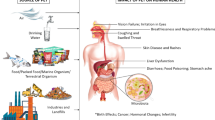Abstract
The available concentration of a slowly released, biologically active substance is the result of the interplay of the processes of release and of decay. In this paper, the theory of the release mechanisms based on diffusion and, also, on water-degradable polymers is examined in detail, and, based on a first-order decay of the released substance, the “present concentration” based on area is calculated. The attainment and maintenance of a constant present concentration over a chosen time period is considered as the ideal. The actual, long-term efficiencies which can be expected vary from 22% for diffusion to 100% for a well-chosen combination of water-degradable polymers and conventional substances. The efficiency varies conversely with toxicity; so, safety and efficiency are simultaneously attainable. The major benefits of controlled release appear only for times encompassing several half-lives of the active substance. This finding encourages the consideration of non-persistent pesticides.
Similar content being viewed by others
References
Allan, G. G., C. S. Chopra, A. N. Neogi, and R. M. Wilkins: Design and synthesis of controlled release pesticide-polymer combinations. Nature234, 349 (1971).
Beasley, M. L., and R. L. Collins: Water-degradable polymers for controlled release of herbicides and other agents. Science169, 769 (1970).
Collins, R. L., S. Doglia, R. A. Mazak, and E. T. Samulski: Controlled release of herbicides-theory. Weed Science21, 1 (1973).
Collins, R. L. and S. Doglia: Concentration of pesticides, slowly released by diffusion. Weed Science21, 343–349 (1973).
Crank, J.: The mathematics of diffusion. Oxford: Clarendon Press (1956).
Fick, A.: Uber-diffusion. Ann. Phys. (Leipzig).170, 59 (1855).
Higuchi, T.: Rate of release of medicaments from ointment bases containing drugs in suspension. J. Pharm. Sci.50, 874 (1961).
Higuchi, T.: Mechanism of sustained-action medication. J. Pharm. Sci.52, 1145 (1963).
Author information
Authors and Affiliations
Additional information
COMMUNICATED BY LOUIS LYKKEN
Rights and permissions
About this article
Cite this article
Collins, R.L., Doglia, S. Theory of controlled release of biologically active substances. Arch. Environ. Contam. Toxicol. 1, 325–346 (1973). https://doi.org/10.1007/BF01985434
Received:
Accepted:
Issue Date:
DOI: https://doi.org/10.1007/BF01985434




